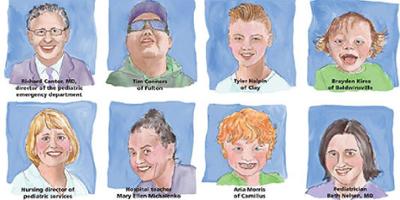Rethinking Kaposi sarcoma: Viral immunologist sees patient improve after treatment for inflammatory response
 Christine King, PhD (photo by William Mueller)
Christine King, PhD (photo by William Mueller)Editor's note: This is one of three articles on Upstate's "renegade researchers" -- scientists who are providing new ways of looking at long-standing medical problems, including Kaposi sarcoma (detailed below), hydrocephalus and schizophrenia.
BY AMBER SMITH
Christine King, PhD, studied both virology and immunology for her doctorate. Years of laboratory research have developed her deep understanding of endothelial cells, mast cells and a disease called Kaposi sarcoma. She is known as a voracious reader of scientific journals.
So, when a 46-year-old man with Kaposi sarcoma developed seemingly random symptoms that were making him miserable soon after he had his appendix removed, infectious disease doctors at Upstate University Hospital asked King if she had any ideas.
Boy, did she.
She proposed a novel treatment that worked.
But first, some background.
A special research lab
King’s lab is focused on the origin and development of viral diseases, particularly those affecting endothelial cells, which line the blood vessels throughout the body. These cells have an innate resistance to cancer, something researchers are trying to better understand. King studies two diseases that are characterized by faulty endothelial cells: dengue fever and Kaposi sarcoma, which is caused by a herpes virus. In severe cases of dengue, endothelial cells become leaky. In advanced Kaposi, the cells proliferate uncontrollably and don’t function properly.
Many doctors who treat patients with Kaposi blame the herpes virus for getting into the endothelial cells and causing inflammation. That’s not how King sees it.
“No virus wants to make you sick. It just wants to survive,” she explains. “When you feel sick from a cold or a flu, it’s the immune response that’s making you feel sick. It’s not the virus.” It’s the same with Kaposi, she says. It’s the body’s immune reaction to the virus that causes the inflammation, which leads to skin lesions and other symptoms.
A team of scientists from various medical schools collaborates with King. They believe Kaposi is dependent not just on the herpes virus but also the body’s immune reaction, and they say the disease will go away if the inflammation goes away.
They also believe it’s not the endothelial cells that initiate the inflammation but their companion cells, mast cells, that do. Mast cells are the cells that release histamine during inflammatory and allergic reactions. They are located in connective and mucosal tissue throughout the body and work closely with endothelial cells.
King noticed that the Kaposi lesions appear in areas where mast cells are prevalent. She began thinking mast cells may play a role in the disease. Blood analyzed from people with Kaposi suggest she is on the right track. “We took random samples, and the levels of mast cell specific mediators were incredibly high, suggesting we have this constant activation going on,” she says.
Testing a theory
Soon she got the chance to test her theory, when infectious disease specialists at Upstate asked for her input on a patient.
The man had been diagnosed with HIV 14 years before, and he had the hallmark lesions of Kaposi sarcoma on his legs and feet. After an emergency appendectomy, those skin lesions began getting darker and bigger. He developed intermittent vertigo, headaches, ringing in his ears, eye pain and a worsening of longstanding symptoms such as gastroesophageal reflux, nausea and diarrhea, achy muscles and joints, night sweats and fatigue. It was like a horrible episode of allergies.
King met with the man and quickly recognized his symptoms as those of mast cell activation. She told him about her laboratory work and what she thought might help him. He was eager to try.
“We hypothesized that his worsening constitutional symptoms and progression of his previously stable Kaposi sarcoma both resulted from extensive mast cell activation triggered by his recent inflammatory appendicitis and abdominal surgery,” King and her colleagues wrote in a journal of the American Association for Cancer Research.
The man took high doses of antihistamines — cetirizine and ranitidine, or Zyrtec and Zantac — which are available over the counter, along with a prescription anti-inflammatory called montelukast, or Singulair, and vitamin C, known as a mast cell stabilizer.
“He did fabulous. His regression was dramatic, and it happened right away,” King recalls. At the man’s follow-up appointment two weeks later, many of his symptoms had gone away. “Over the next three months, they continued to resolve. His lesions shrank. He felt better. He told me he felt the best he’d felt in years and years and years.”
Success in a single patient doesn’t prove anything. But, this case gives King and her team more to explore. They’re gathering data for a future clinical trial that could find an affordable and effective way to treat Kaposi.
Meanwhile, the researchers are getting the word out by presenting their findings at international scientific conferences and in medical journals. The medications they’re working with are relatively inexpensive, have been in use long term and are readily available, so doctors with Kaposi patients may want to try the combination. Says King: “I suspect it’s going to work in most patients.”
(Click here to hear King discuss her work in a podcast/radio interview on Upstate's "HealthLink on Air.")
About Kaposi sarcoma
This cancer develops from the cells that line lymph or blood vessels and usually appears as lesions on the skin (which may be purple, red or brown) or mucous membranes inside the mouth, lungs, stomach or intestines.
In America, most cases of Kaposi are seen in people with human immunodeficiency virus, or HIV, but the disease can also affect people with reduced immunity, such as those who have undergone an organ transplant. In other parts of the world, Kaposi is prevalent among the general population, including people who do not have HIV.
Kaposi can be treated with chemotherapy, radiation or surgery to remove the lesions, but the disease often returns.
Source: American Cancer Society
This is what helped the patient
A 46-year-old man with Kaposi sarcoma suffered multiple symptoms that went away soon after he started taking:
- 20 milligrams cetirizine, daily (commonly used for allergy relief, it is a type 1 histamine receptor antagonist also known as Zyrtec, available over the counter)
- 300 milligrams ranitidine, twice a day (commonly used to relieve stomach acid and digestive problems, it is a type 2 histamine receptor antagonist also known as Zantac, available over the counter)
- 10 milligrams montelukast, daily (commonly used to treat asthma, it is a leukotriene receptor antagonist also known as Singulair, which requires a prescription)
- 1 gram vitamin C, daily (a mast cell stabilizer)
Source: a journal of the American Association for Cancer Research called Clinical Cancer Research, July 2018.
 This article appears in the summer 2019 issue of Upstate Health magazine.
This article appears in the summer 2019 issue of Upstate Health magazine.




